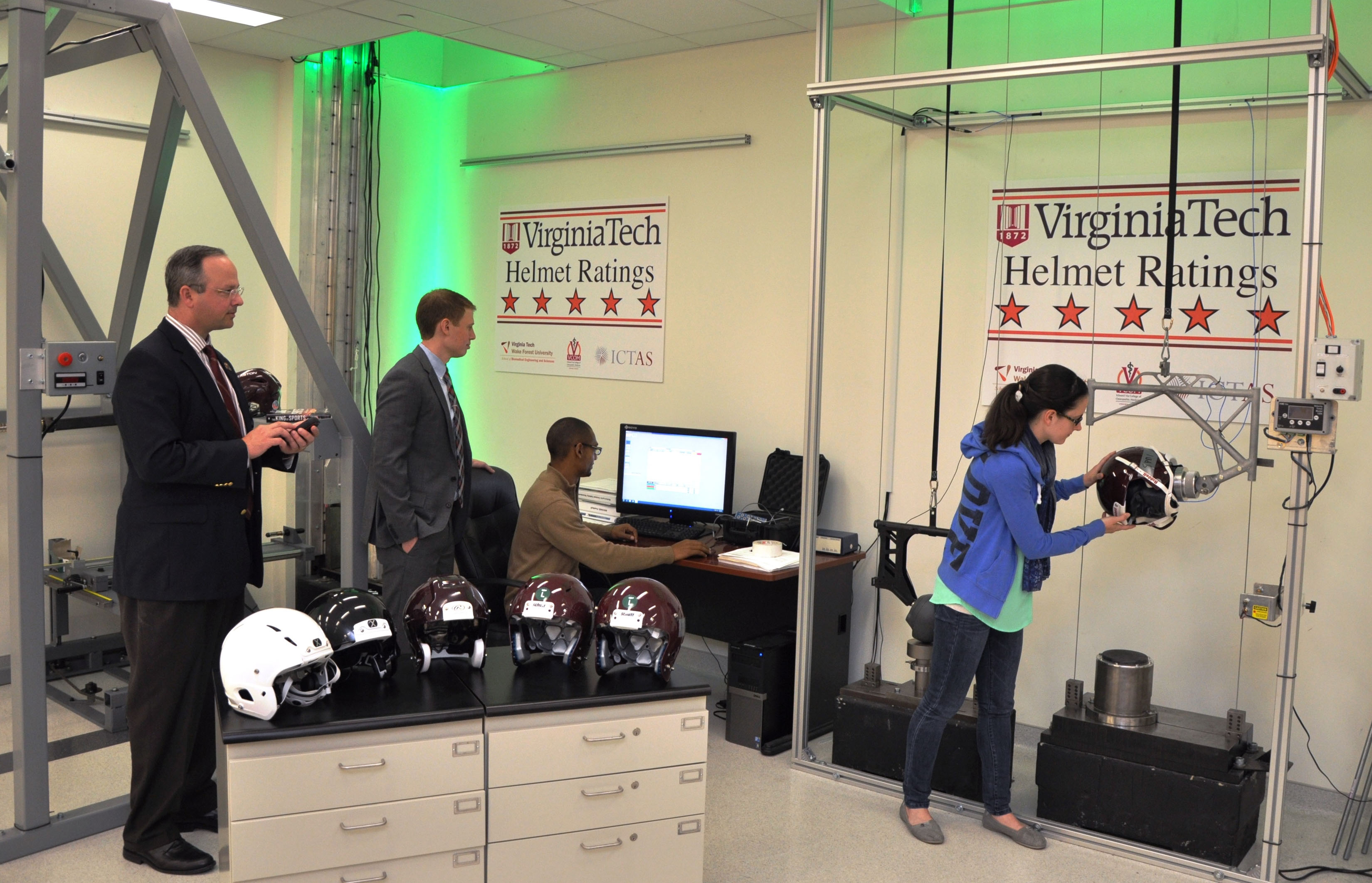New ratings announced as five new football helmets meet highest marks

Virginia Tech has updated its adult football helmet ratings, which are designed to identify key differences between the abilities of individual helmets to reduce the risk of concussion. All five of the new adult football helmets introduced this spring earned the five-star mark, the highest rating awarded by the Virginia Tech Helmet Ratings™.
The complete ratings of the helmets manufactured by Schutt Sports and Xentih LLC, each with two new products, and Rawlings Sporting Goods Co., with one helmet, are publicly available at helmet ratings website.
The new helmets are Schutt’s Vengeance VTD and AiR XP Pro VTD, Rawlings’ Tachyon; and Xenith’s EPIC and X2E. Virginia Tech will continue to update its helmet ratings at the request of manufacturers as new helmets are sold. This brings to nine the number of helmets with the best available rating since the rating system was introduced by Virginia Tech in 2011. At that time, only one helmet rated five stars.
Helmet ratings are based on research that includes analysis of more than 2 million head impacts recorded directly from high school and collegiate football players using helmet-mounted sensors. These data were used to create lab testing conditions representative of all the impacts players experience on the field.
Each helmet model’s ability to reduce concussion risk is assessed through 120 impact tests that are analyzed using the STAR Evaluation System, with each test weighted based on how often that impact condition occurs on the field. Helmets that better manage the impact energy result in lower head accelerations and thereby lower concussion risk. To date, 23 helmet models have been evaluated through the analysis of more than 2,700 laboratory tests.
“The Institute of Medicine released a recent report on concussion in sports that found our helmet rating system to be a theoretically grounded approach on how the injury mitigation properties of helmets could be assessed,” said Stefan Duma, the Virginia Tech Harry C. Wyatt Professor and department head of biomedical engineering, and project leader.
The research is funded by the National Institutes of Health, which Duma said is being directly used to reduce player injuries. The impact of Duma’s research has been noticed: The NFL has placed a poster of the helmet ratings system in its 32 locker rooms to educate players on helmet safety. Duma expects all future football helmets to be five-star rated.
“Consumers care about safety, and as a result, helmets that are rated poorly are not selling,” he added. “This is going to continue to drive helmet design.”
Added Steven Rowson, assistant professor of biomedical engineering at Virginia Tech: “This is remarkable progress for helmet safety in football. Not only are consumers using the ratings to purchase helmets, but manufacturers are using our rating system to design new helmets to achieve five stars.”
“Our tests are representative of the impacts that players experience on the field, so helmets that perform well in our tests are going to perform well on the field, making the sport of football safer,” said Rowson, who developed the STAR system and testing of the helmets.
Duma and Rowson confirmed this in a peer-reviewed study investigating concussion rates in collegiate football players by helmet type and published in the Journal of Neurosurgery. “We found that concussion risk was 54 percent lower in players wearing a four-star helmet compared to a one-star helmet,” said Rowson. “This closely matches the reduction in concussion risk that our ratings predict. It’s great to see agreement like this between our on-field and in-laboratory studies.”
Ratings this fall will be expanded to include hockey helmets using newly developed testing methods. The hockey ratings will incorporate both linear and rotational acceleration into the evaluation system, following a report from the Institute of Medicine that suggested that Virginia Tech add rotational acceleration and youth specific data to increase the wide-spread applications of the helmet system.
Football helmet ratings methodology will be updated in 2015 to include linear and rotational acceleration, which will include for the first time youth helmets. Duma and Rowson earlier laid five-year plans for evaluating helmets in all sports.
The researchers are careful to warn that any player in any sport can sustain a concussion, even with the best head protection. Virginia Tech’s rating system identifies helmets that best reduce the risk of concussion during play. “There is no concussion-proof helmet,” said Duma. “Modifying rules and teaching proper technique play the most important in reducing concussions in sports because they reduce exposure to head impact. For the remaining head impacts that do occur, having the best head protection will further reduce risk of concussion.”
The ratings system is independent of any helmet manufacturer and utilizes funding from private donations, the Virginia Tech School of Biomedical Engineering and Sciences, and Virginia Tech’s Institute for Critical Technology and Applied Science. Detailed reports that outline the methodology and resulting data are available on the ratings’ website.




